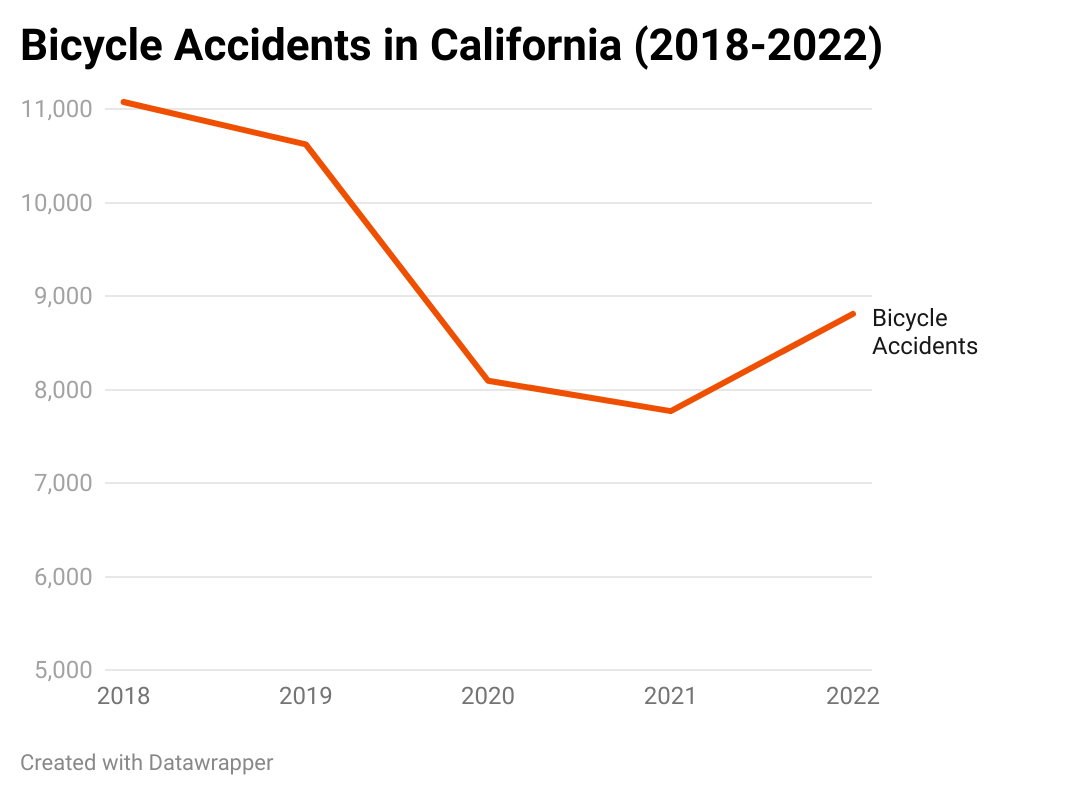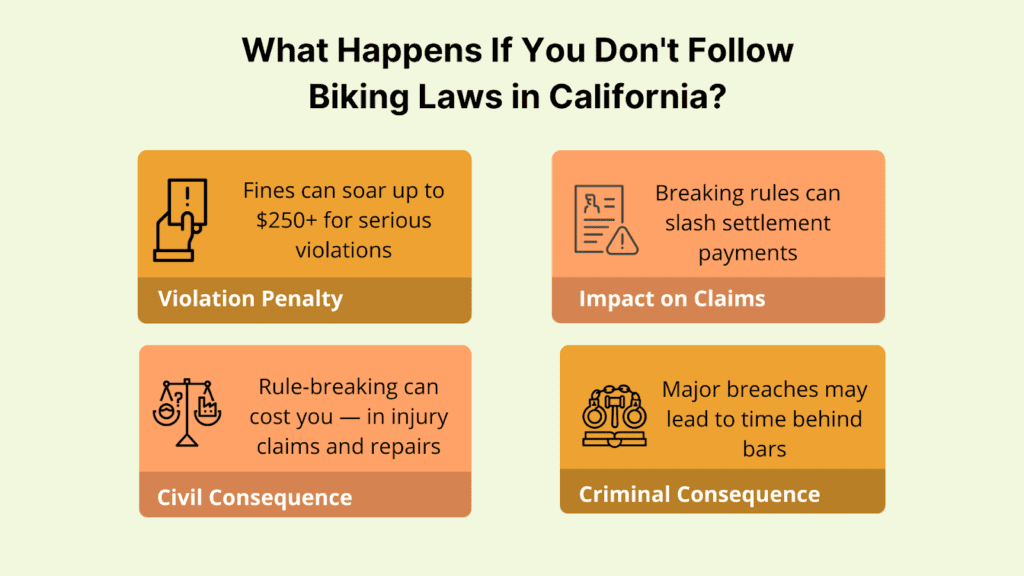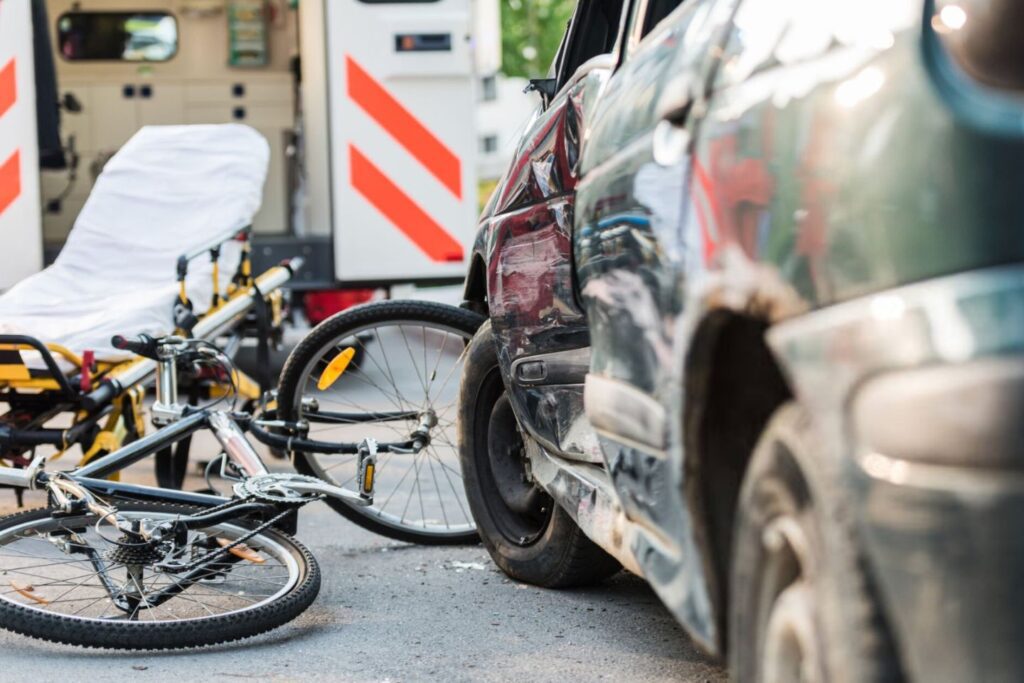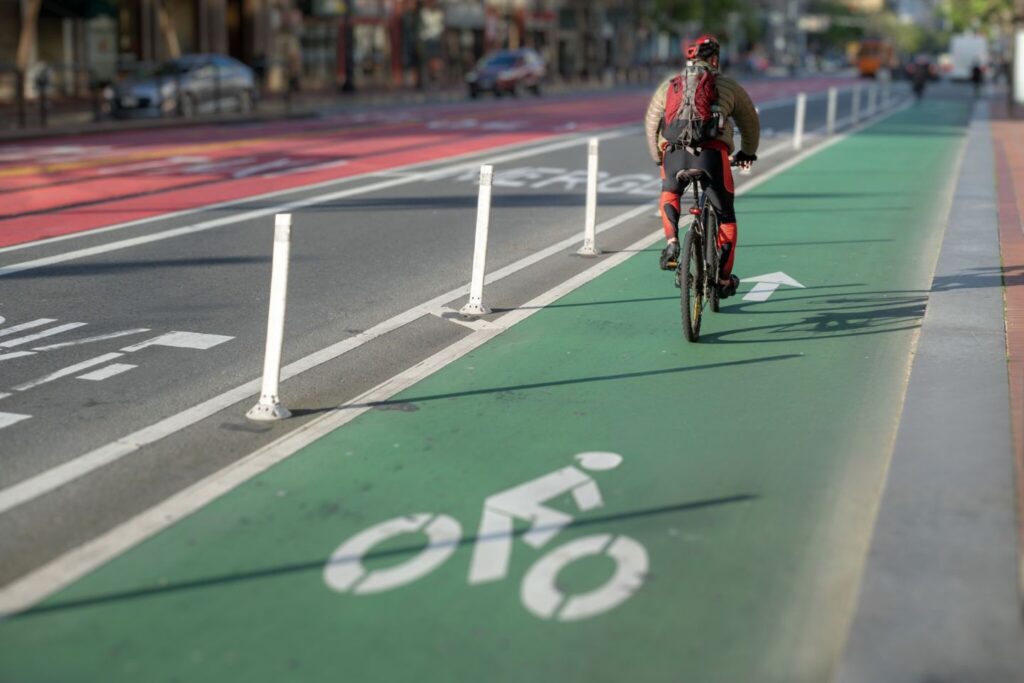According to the California Highway Patrol’s Statewide Integrated Traffic Record System (SWITRS), there have been a staggering 9,203 bicycle accidents in California from 2018 to 2022. This alarming statistic highlights a critical need for both novice and experienced cyclists to understand biking regulations in California.


They are not just guidelines for safer cycling but can also be crucial in protecting your rights and interests in the aftermath of an accident. As we explore biking laws in California, remember that this knowledge is your first line of defense on the road. Let’s ensure your next ride is not only enjoyable but also secure.
Biking Laws California: Rules of the Road


Navigating California’s roads on a bike requires knowledge of specific laws to ensure safety and compliance.
Here’s a breakdown of essential biking laws in California.
Right of Way and Lane Usage
According to CVC 21202, cyclists in California are required to ride in the same direction as traffic and stay as close to the right-hand curb as possible. The right-of-way rule, however, has exceptions.
Cyclists can move away from the right-hand side when overtaking another bicycle or vehicle, making a left turn, navigating around road hazards, or if the lane is too narrow for a bicycle and a vehicle to travel safely side by side.
When it comes to bike lanes, the law is clear: if a bike lane is present, cyclists must use it. However, cyclists may leave the bike lane when preparing for a left turn, overtaking another bicycle or vehicle, or when avoiding hazards in the bike lane such as debris or parked cars.
Sidewalk biking is another area governed by specific regulations, which can vary significantly from one city to another in California.
- Example: Cities like San Francisco generally prohibit biking on sidewalks, especially in business districts, to ensure pedestrian safety. In contrast, other areas like Los Angeles have more lenient rules, allowing sidewalk biking in many parts of the city. Cyclists need to familiarize themselves with the local laws in their area to ensure they are compliant.
Equipment and Safety Laws
Ensuring you have the right equipment and adhere to safety laws is key to a secure biking experience in California.
- Helmet Law (CVC 21212): For cyclists under 18, wearing a bicycle helmet is a legal requirement. While it’s not mandatory for adults, wearing a helmet is strongly advised for everyone’s safety. A proper helmet can be a lifesaver in the event of an accident.
- Lighting (CVC 21201): When riding at night, your bicycle must be equipped with a white light visible from the front and a red reflector that is visible from the back. Additionally, using a red light that’s visible from the rear is recommended. This is crucial for visibility, ensuring that other road users can see you.
- Brakes (CVC 21201(a)): Your bicycle must have a brake that allows you to make a one-braked-wheel skid on dry, level, and clean pavement. Effective brakes are essential for controlling your speed and safely navigating traffic and road conditions.
- Earphones and Headsets (CVC 27400): It’s illegal to ride with earphones or headsets that cover both ears. This law ensures that cyclists can hear traffic, emergency signals, and other important sounds while riding, which is vital for situational awareness and safety.
Intersections and Signaling Laws
Navigating intersections safely and effectively is a critical aspect of biking in California. Cyclists are required to follow specific laws regarding right-of-way and signaling for intersections and u-turns to ensure their safety and that of others on the road.
- Right-of-Way at Intersections (CVC 21800-21804): Cyclists are subject to the same right-of-way rules as motor vehicles. This means they must yield to pedestrians and follow the established right-of-way protocol at intersections. Understanding and adhering to these rules helps in preventing collisions and ensures smoother traffic flow.
- Signaling (CVC 22107): Effective communication with other road users is key, and that’s where signaling comes in. Cyclists must use hand signals when making turns or stopping. To signal a left turn, extend your left hand horizontally; for a right turn, you can either extend your right hand horizontally or use your left hand pointed upwards. When stopping, signal by pointing your left hand downwards. These signals must be given at least 100 feet before the turn or stop, where safe and practical.
Legal Responsibilities and Consequences of Violating Biking Laws in California


Being a responsible cyclist in California means not only understanding the biking laws but also being aware of the legal responsibilities and potential consequences of violating these laws.
Penalties for Violation
Violating biking laws in California can lead to various penalties. For example, failing to meet lighting requirements can result in a fine. More serious offenses, such as biking under the influence, governed by CVC 21200.5, can result in substantial fines and potentially criminal charges. Penalties can vary, starting at $20 for less serious violations, and escalating to over $250 for major offenses, including DUI.
Civil Consequences
Apart from legal penalties, violating biking laws can have civil consequences. If a cyclist’s unlawful behavior leads to an accident, they could be held liable for damages under California’s personal injury laws. This includes medical expenses, property damage, and other compensation claims made by those injured due to the violation.
Criminal Consequences
In more severe cases, such as hit-and-run incidents covered under CVC 20001, or causing serious injury while violating biking laws, cyclists may face criminal charges. These charges can lead to a criminal record, hefty fines, and in extreme cases, imprisonment.
Impact on Future Claims
Violating biking laws can significantly impact a cyclist’s ability to claim damages or compensation in the event of an accident. Under California’s comparative negligence laws, if a cyclist is found partially at fault due to a violation, their compensation could be reduced proportionally.
What to do in Case of a Bike Accident in California?


Experiencing a bike accident can be stressful. However, knowing the right steps to take can significantly impact the outcome, especially when it comes to your safety and legal rights.
Here’s a guide on what to do if you find yourself in a bike accident in California.
- Ensure Safety and Seek Medical Attention: Your first priority should be to move to a safe location if you’re able to do so. Check for injuries and seek medical attention immediately, even if injuries seem minor. Under CVC 20003, if anyone is injured or killed, you must give reasonable assistance, which may include making arrangements for transportation to medical treatment.
- Report the Accident: California law (CVC 20008) mandates that any bicycle accident resulting in injury or death must be reported to the California Highway Patrol or the police department of the city where the accident occurred within 24 hours of the incident. This is crucial for legal documentation.
- Document the Scene and Gather Information: If possible, take photos of the accident scene, your injuries, and damages to your bike. Collect contact and insurance information from all parties involved, and details from witnesses. This information can be vital for insurance claims or legal proceedings.
- Do Not Admit Fault: It’s important not to admit fault at the scene or make statements that could be interpreted as an admission of liability. The determination of fault should be left to legal and insurance professionals.
- Notify Your Insurance Company: Report the accident to your insurance company as soon as possible. Even if you’re not at fault, your insurer can guide the next steps and may cover certain costs under your policy.
- Consult with a Bicycle Accident Attorney: An attorney can be an invaluable source to protect your rights and guide you through the complex legal processes following a bicycle accident, especially in cases with significant injuries or intricate legal challenges.
At The Personal Injury Center, we are dedicated to connecting you with expert lawyers in your area so you can navigate these challenging situations with confidence. Contact us today for a free evaluation.
- Filing a Lawsuit: Filing a lawsuit is essential for seeking the rightful compensation after a bicycle accident in California. It’s crucial to be aware of the Statute of Limitations which sets a two-year deadline from the date of the accident to initiate a personal injury lawsuit. Adhering to this time limit is vital, as failing to file within this period can lead to the forfeiture of your right to claim compensation. .
Liability and Compensation in California’s Biking Accidents
Managing the aftermath of a biking accident in California involves understanding the complex interplay of liability and compensation. This understanding is key to protecting your rights and ensuring you receive the appropriate recompense for any losses incurred during the accident.
Determining Liability in Bike Accidents
In California, the principle of comparative negligence, as outlined in the California Civil Code 1714, plays a crucial role in biking accidents. Under this principle, each party involved in the accident is assigned a percentage of fault.
For example, if you, as a cyclist, are found to be 20% at fault in an accident, your compensation will be reduced by 20%. Liability is not always straightforward and is determined based on various factors, such as adherence to traffic laws, the actions of the cyclist and the driver, the conditions of the road, and any available witness testimonies.
Types of Compensation
In California, the compensation for bicycle accident victims covers a wide range.
- Medical Expenses: Compensation for medical expenses is a key component in bicycle accident cases. This covers immediate and future medical needs resulting from the accident, ranging from emergency care to long-term rehabilitation services.
- Lost Wages and Earning Capacity: For victims whose injuries affect their ability to work, compensation may include loss of income and even the potential loss of future earning capacity.
- Pain and Suffering: This type of compensation recognizes the physical and emotional distress caused by the accident. It addresses the non-economic impact on the victim’s life.
- Property Damage: Compensation also extends to cover property damage, which includes repairs or replacement of the bicycle and other personal items that were damaged in the incident.
It’s important to note that the value of settlements in bicycle accident cases can vary widely. According to Thomson Reuters, while the average monetary award for personal injury cases in California is around $1.8 million, the median settlement figure is approximately $114,000. However, every case is unique, and specific circumstances greatly influence the settlement value.
Seeking Legal Counsel After a Bicycle Accident in California?
Dealing with the repercussions of a bicycle accident in California can be overwhelming. This is where The Personal Injury Center steps in, offering invaluable support and expertise in these challenging times.
Get in touch with us and we will link you with an expert personal injury attorney who has a deep understanding of bicycle accident cases in California. We are committed to providing you with the essential knowledge and tools so you can navigate your legal journey with confidence and clarity.
Key Takeaways
|



